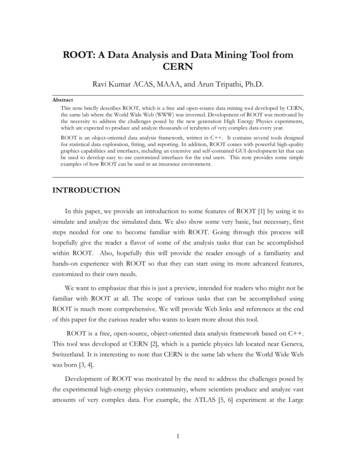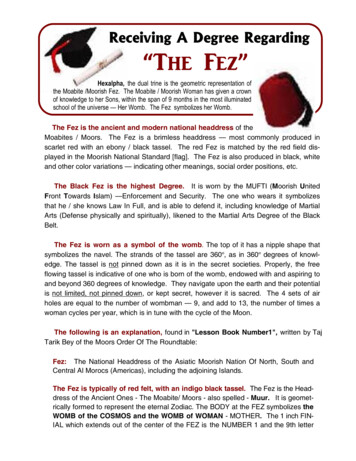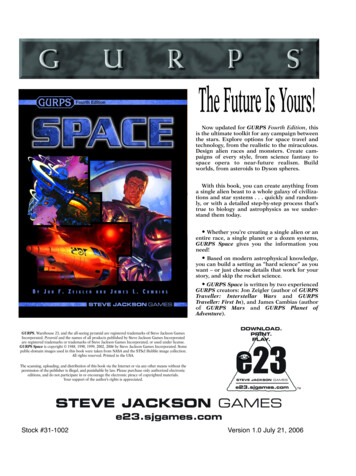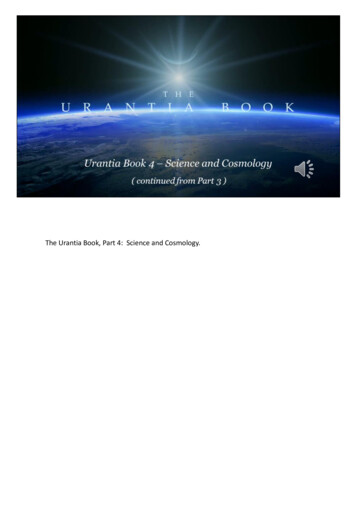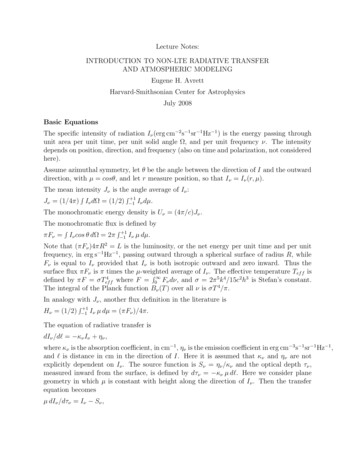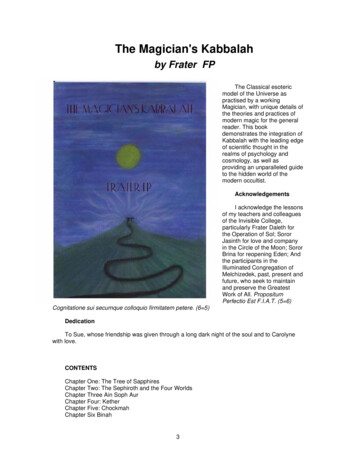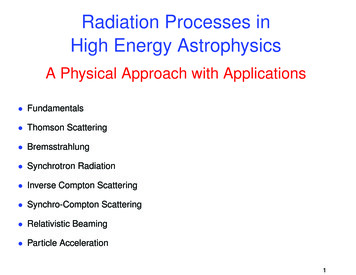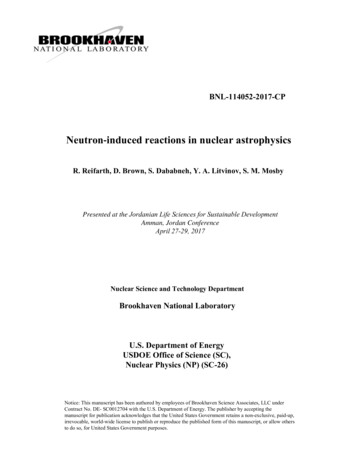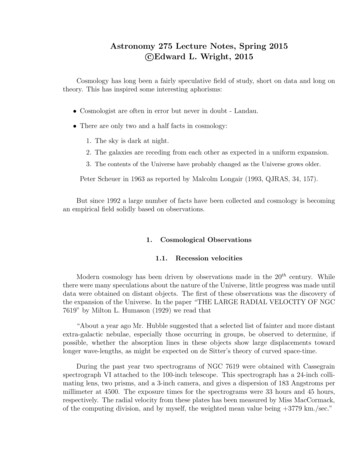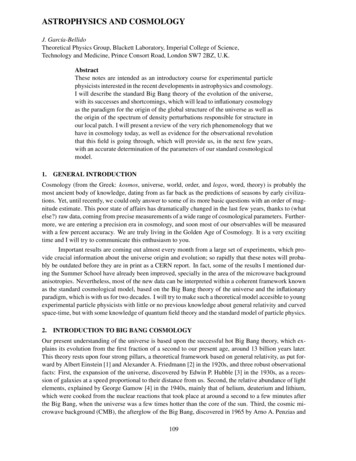
Transcription
ASTROPHYSICS AND COSMOLOGYJ. Garcı́a-BellidoTheoretical Physics Group, Blackett Laboratory, Imperial College of Science,Technology and Medicine, Prince Consort Road, London SW7 2BZ, U.K.AbstractThese notes are intended as an introductory course for experimental particlephysicists interested in the recent developments in astrophysics and cosmology.I will describe the standard Big Bang theory of the evolution of the universe,with its successes and shortcomings, which will lead to inflationary cosmologyas the paradigm for the origin of the global structure of the universe as well asthe origin of the spectrum of density perturbations responsible for structure inour local patch. I will present a review of the very rich phenomenology that wehave in cosmology today, as well as evidence for the observational revolutionthat this field is going through, which will provide us, in the next few years,with an accurate determination of the parameters of our standard cosmologicalmodel.1. GENERAL INTRODUCTIONCosmology (from the Greek: kosmos, universe, world, order, and logos, word, theory) is probably themost ancient body of knowledge, dating from as far back as the predictions of seasons by early civilizations. Yet, until recently, we could only answer to some of its more basic questions with an order of magnitude estimate. This poor state of affairs has dramatically changed in the last few years, thanks to (whatelse?) raw data, coming from precise measurements of a wide range of cosmological parameters. Furthermore, we are entering a precision era in cosmology, and soon most of our observables will be measuredwith a few percent accuracy. We are truly living in the Golden Age of Cosmology. It is a very excitingtime and I will try to communicate this enthusiasm to you.Important results are coming out almost every month from a large set of experiments, which provide crucial information about the universe origin and evolution; so rapidly that these notes will probably be outdated before they are in print as a CERN report. In fact, some of the results I mentioned during the Summer School have already been improved, specially in the area of the microwave backgroundanisotropies. Nevertheless, most of the new data can be interpreted within a coherent framework knownas the standard cosmological model, based on the Big Bang theory of the universe and the inflationaryparadigm, which is with us for two decades. I will try to make such a theoretical model accesible to youngexperimental particle physicists with little or no previous knowledge about general relativity and curvedspace-time, but with some knowledge of quantum field theory and the standard model of particle physics.2. INTRODUCTION TO BIG BANG COSMOLOGYOur present understanding of the universe is based upon the successful hot Big Bang theory, which explains its evolution from the first fraction of a second to our present age, around 13 billion years later.This theory rests upon four strong pillars, a theoretical framework based on general relativity, as put forward by Albert Einstein [1] and Alexander A. Friedmann [2] in the 1920s, and three robust observationalfacts: First, the expansion of the universe, discovered by Edwin P. Hubble [3] in the 1930s, as a recession of galaxies at a speed proportional to their distance from us. Second, the relative abundance of lightelements, explained by George Gamow [4] in the 1940s, mainly that of helium, deuterium and lithium,which were cooked from the nuclear reactions that took place at around a second to a few minutes afterthe Big Bang, when the universe was a few times hotter than the core of the sun. Third, the cosmic microwave background (CMB), the afterglow of the Big Bang, discovered in 1965 by Arno A. Penzias and109
Robert W. Wilson [5] as a very isotropic blackbody radiation at a temperature of about 3 degrees Kelvin,emitted when the universe was cold enough to form neutral atoms, and photons decoupled from matter,approximately 500,000 years after the Big Bang. Today, these observations are confirmed to within a fewpercent accuracy, and have helped establish the hot Big Bang as the preferred model of the universe.2.1 Friedmann–Robertson–Walker universesWhere are we in the universe? During our lectures, of course, we were in Časta Papiernička, in ‘the heartof Europe’, on planet Earth, rotating (8 light-minutes away) around the Sun, an ordinary star 8.5 kpc1from the center of our galaxy, the Milky Way, which is part of the local group, within the Virgo cluster of galaxies (of size a few Mpc), itself part of a supercluster (of sizeMpc), within the visible universe Mpc), most probably a tiny homogeneous patch of the infinite global structure of space( time, much beyond our observable universe.Cosmology studies the universe as we see it. Due to our inherent inability to experiment with it,its origin and evolution has always been prone to wild speculation. However, cosmology was born as ascience with the advent of general relativity and the realization that the geometry of space-time, and thusthe general attraction of matter, is determined by the energy content of the universe [6], "!#% & ')( *(1) These non-linear equations are simply too difficult to solve without some insight coming from the symmetries of the problem at hand: the universe itself. At the time (1917-1922) the known (observed) universe extended a few hundreds of parsecs away, to the galaxies in the local group, Andromeda and theLarge and Small Magellanic Clouds: The universe looked extremely anisotropic. Nevertheless, both Einstein and Friedmann speculated that the most ‘reasonable’ symmetry for the universe at large should behomogeneity at all points, and thus isotropy. It was not until the detection, a few decades later, of themicrowave background by Penzias and Wilson that this important assumption was finally put onto firmexperimental ground. So, what is the most general metric satisfying homogeneity and isotropy at largescales? The Friedmann-Robertson-Walker(FRW) metric, written here in terms of the invariant geodesic 3 3 314, see Ref. [6],2distance , -/. ,10 ,10 in four dimensions, 2,5- .,16 . 87. 9 6;:,1 . 8 ' . . 9 , .')? @ A. B,5C . :3(2)7characterized by just two quantities, a scale factor 9 6;: , which determines the physical size of the universe, and a constant , which characterizes the spatial curvature of the universe, H IKJ#LNMD E F G * H OQPSRUT7(3) H ' VWPXIKYZL#[. 9 6;:Spatially open, flat and closed universes have different geometries. Light geodesics on these universesbehave differently, and thus could in principle be distinguished observationally, as we shall discuss later.Apart from the three-dimensional spatial curvature, we can also compute a four-dimensional space-timecurvature,7 7D \]F '*. 'G 7G 7G 7(4).Depending on the dynamics (and thus on the matter/energy content) of the universe, we will have differentpossible outcomes of its evolution. The universe may expand for ever, recollapse in the future or approachan asymptotic state in between.12One parallax second (1 pc), parsec for short, corresponds to a distance of about 3.26 light-years or acbed fhg cm.I am using iBjkb everywhere, unless specified.110
2.1.1The expansion of the universeIn 1929, Edwin P. Hubble observed a redshift in the spectra of distant galaxies, which indicated that theywere receding from us at a velocity proportional to their distance to us [3]. This was correctly interpretedas mainly due to the expansion of the universe, that is, to the fact that the scale factor today is largerthan when the photons were emitted by the observed galaxies. For simplicity, consider the metric of a 7. 9 6 :S,Q0 l . (the generalization of the following argument to curvedspatially flat universe, , - ., 6.7space is straightforward). The scale factor 9 6 : gives physical size to the spatial coordinates l0 , and theexpansion is nothing but a change of scale (of spatial units) with time. Except for peculiar velocities, i.e.motion due to the local attraction of matter, galaxies do not move in coordinate space, it is the space-timefabric which is stretching between galaxies. Due to this continuous stretching, the observed wavelengthof photons coming from distant objects is greater than when they were emitted by a factor precisely equalto the ratio of scale factors,m npo;q7 tm res 7 '8u 3(5)7 twhereis the present value of the scale factor. Since the universe today is larger than in the past, theuobserved wavelengths will be shifted towards the red, or redshifted, by an amount characterized by , theredshift parameter.In the context of a FRW metric, the universe expansion is characterized by a quantity known as thet779 6;:xw 9 6 : , whose value today is denoted by v . As I shall deduce later,Hubble rate of expansion, v 9 6 :it is possible to compute the relation between the physical distance , y and the present rate of expansion,in terms of the redshift parameter,3 t u ' {z t u '8 u E *9 :v , y: .(6) 9u } At small distances from us, i.e. at, we can safely keep only the linear term, and thus the recession u tv , y , the proportionality constantvelocity becomes proportional to the distance from us, tbeing the Hubble rate, v . This expression constitutes the so-called Hubble law, and is spectacularlyconfirmed by a huge range of data, up to distances of hundreds of megaparsecs. In fact, only recentlyu , were obtained, and are beginning tomeasurements from very bright and distant supernovae, atz tprobe the second-order term, proportional to the deceleration parameter , see Eq. (22). I will comeback to these measurements in Section 3.One may be puzzled as to why do we see such a stretching of space-time. Indeed, if all spatialdistances are scaled with a universal scale factor, our local measuring units (our rulers) should also bestretched, and therefore we should not see the difference when comparing the two distances (e.g. the twowavelengths) at different times. The reason we see the difference is because we live in a gravitationallybound system, decoupled from the expansion of the universe: local spatial units in these systems are notstretched by the expansion.4 The wavelengths of photons are stretched along their geodesic path fromone galaxy to another. In this consistent world picture, galaxies are like point particles, moving as a fluidin an expanding universe.2.1.2The matter and energy content of the universeSo far I have only discussed the geometrical aspects of space-time. Let us now consider the matter andenergy content of such a universe. The most general matter fluid consistent with the assumption of homogeneity and isotropy is a perfect fluid, one in which an observer comoving with the fluid would see theuniverse around it as isotropic. The energy momentum tensor associated with such a fluid can be written as [6] ' ') 39:S (7) 34The subscript refers to Luminosity, which characterizes the amount of light emitted by an object. See Eq. (61).The local space-time of a gravitationally bound system is described by the Schwarzschild metric, which is static [6].111
9 6;: and 9 6;: are the pressure and energy density of the fluid at a given time in the expansion, andwhere is the comoving four-velocity, satisfying .Let us now write the equations of motion of such a fluid in an expanding universe. According togeneral relativity, these equations can be deduced from the Einstein equations (1), where we substitute the FRW metric (2) and the perfect fluid tensor (7). The 2component of the Einstein equationsconstitutes the so-called Friedmann equation;!#( 7 ' .377v .(8)44.(where I have treated the cosmological constant as a different component from matter. In fact, it canbe associated with the vacuum energy of quantum field theory, although we still do not understand whyshould it have such a small value (120 orders of magnitude below that predicted by quantum theory), if itis non-zero. This constitutes today one of the most fundamental problems of physics, let alone cosmology. ), a direct consequence of the general covariance of theThe conservationof energy ( theory (), can be written in terms of the FRW metric and the perfect fluid tensor (7) as,1, 6 c7 E') ,1, 67 E B3(9) k' 3where the energy density and pressure can be split into its matter and radiation components, 5 H 3 4 5 ' 5 , with corresponding equations of state,w . Together, the Friedmannand the energy-conservation equation give the evolution equation for the scale factor,7 !#( ' 4 '397:(10)44tI will now make a few useful definitions. We can write the Hubble parameter today v in units of100 km s Mpc & , in terms of which one can estimate the order of magnitude for the present size andage of the universe,t B 8 & ?3 & " ¡Q 1 & v(11) t4 B 3 & B ¡Q (12)v * 4Q *t & # § v (13) * for decades, and only in the last fewThe parameter has been measured to be in the range ª *G « . I will discuss those recent measurements in theyears has it been found to lie within 10% ofnext Section. One can also define a critical density , that which in the absence of a cosmological constant wouldcorrespond to a flat universe,4 t v . * E. .p # w "!N(14)E * 3 & p # w 9 & ¡² :(15)pEE * g is a solar mass unit. The critical density corresponds to approximately 4where protons per cubic meter, certainly a very dilute fluid! In terms of the critical density it is possible to define the ratios ³B µw , for matter, radiation, cosmological constant and even curvature, today,;!#% "!#% ¶³³(16)4 t4 tv .v .( *7 t t(17)³Q·³B 4 tv . v .112
We can evaluate today the radiation component ³ , correspondingto relativistic particles,from the &¹ º »¼ ¾½ ¿ B¹ º » \ E* Ep\ E9x w «: w 9pà :, whichdensity of microwave background photons, ¹ º » * ÁÀ gives ³ À . . Three massless neutrinos contribute an even smaller amount. Therefore,we can safely neglect the contribution of relativistic particles to the total density of the universe today,which is dominated either by non-relativistic particles (baryons, dark matter or massive neutrinos) or bya cosmological constant, and write the rate of expansion vª. in terms of its value today,7 \t7 Et7 t7 ' ''*.t\E77v . 9 :v . ³³³²·³B 7(18).An interesting consequence of these redefinitions is that I can now write the Friedmann equation today,7 7 t, as a cosmic sum rule, Ä'' 3(19)³³Q·³B today. That is, in the context of a FRW universe, the total fraction of matterwhere we have neglected ³density, cosmological constant and spatial curvature today must add up to one. For instance, if we measureone of the three components, say the spatial curvature, we can deduce the sum of the other two. Makinguse of the cosmic sum rule today, we can write the matter and cosmological constant as a function of the7 tK scale factor ()tÅÇ ÉÆ È;!#% 7³3ÅÇ &ÆKÈ Ê77 ' 87 '7 E 87(20)³ 9 :4 v . 9 :³ 9:³Q· 9:tÅÇ ÉÆ È(7 E *7³ ·ÅÇ &ÆKÈ Ê7 ' {7 '7 E 877³Q· 9 :(21)4 ³ 9:³Q· 9:v . 9 :7Ë} This implies that for sufficiently early times,, all matter-dominated FRW universes can be de 3 5). On the other hand, the vacuum energyscribed by Einstein-de Sitter (EdS) models ( ³ ³ ·will always dominate in the future.Another relationship which becomes very useful is that of the cosmological deceleration parameterzt, in terms of the matter and cosmological constant components of the universe, see Eq. (10),7 z t 37(22)³Q· ³tv .zt which is independent of the spatial curvature. Uniform expansion corresponds toand requires a Ì ³²· . It represents spatial sections that are expanding at a fixed rate, its scaleprecise cancellation: ³factor growing by the same amount in equally-spaced time intervals. Accelerated expansion correspondszpt ³Q· : spatial sections expand at an increasing rate, their scaleto and comes about whenever ³z tÎÍ factor growing at a greater speed with each time interval. Decelerated expansion corresponds to Í ³Q· : spatial sections expand at a decreasing rate, their scale factor growingand occurs whenever ³at a smaller speed with each time interval.today,2.1.3Mechanical analogyIt is enlightening to work with a mechanical analogy of the Friedmann equation. Let us rewrite Eq. (8) as( 7 AZ?xÐ]Ñ;A Ð 37 . µÏ7(23) . G\E E ½ 7is the equivalent of mass for the whole volume of the universe. Equation (23) canwhere 'ÔÓfor a test particle of unit mass in the centralbe understood as the energy conservation law Òpotential 'Ó 39 Z:(24)  . 5Note that in the limit Õ Ö8d the radiation component starts dominating, see Eq. (18), but we still recover the EdS model.113
corresponding to a Newtonian potential plus a harmonic oscillator potential with a negative spring con ( 4( w . Note that, in the absence of a cosmological constant (), a critical universe, definedstant Âas the borderline between indefinite expansion and recollapse, corresponds, through the Friedmann equa tions of motion, precisely with a flat universe (). In that case, and only in that case, a spatially ¾ ) corresponds to an eternally expanding universe, and a spatially closed universeopen universe ( Ø' ) to a recollapsing universe in the future. Such a well known (textbook) correspondence is( incorrect when ³Q·8Ù : spatially open universes may recollapse while closed universes can expand forever. One can see in Fig. 1 a range of possible evolutions of the scale factor, for various pairs of values 3of 9 ³³Q·²: .3.03.0B2.5Û2.0AC2.5Þ2.0No 01.0K0.5LM0.5F0.00.0-3-2-10123-3-2-1Fig. 1: Evolution of the scale parameter with respect to time for different values of matter density and cosmological parameter.ºThe horizontal axis represents æ¼j ç èpéëêXì êíèxî , while the vertical axis is ïðj Õ ñeÕ è in each case. The values of ( òò ó )&for different plots are: A (1,0), B (0.1,0), C (1.5,0), D (3,0), E (0.1,0.9), F (0,1), G (3,.1), H (3,1), I (.1,.5), J (.5, ì²b ),,K (1.1,2.707), L (1,2.59), M (0.1,1.5), N (0.1,2.5). From Ref. [7].One can show that, for ³Q·ôÙ 7 t 7 Í , for which õ 9 0²:0wv .E 'õ 9 0²:0 ³0õ ö 9 0²:40 . ³ v, a critical universe ( v) corresponds to those pointsÍ 79 : and õ ö 9 0 : vanish, while õ ö ö 9 0²:, . ³Q Ä' 0 ³B '³Q· Q3 (25)00114 4 ³B w ³Í 3(26)
õ ö ö 9 0²:G 0 ³ ' ³Q ' ³B ³ B Í Í0 0Using the cosmic sum rule (19), we can write the solutions as ³Q· ? @ A E E Ñ ? @ A 9 ³ ³ & : ùø³³³B ø 4 w ³ Ìú Ìû **(27)(28)Í 7ð ýü(), and ³B , while the secondoneThe first solution corresponds to the critical point 0 þø ÿ \ Eø 4 9³³Q w ³ , and ³Q : w ³Q. , for. Expanding around ³, we find ³Q·to 0 û . Ì 3. These critical solutions are asymptotic to the Einstein-de Sitter model ( ³), see³³Q·Fig. 2.3.0ce ounB2.52.01.5ΩΛgatinelerccAing celerat eDExpansion ecollapseC l RosedO �ò ó î . º The line ò ó jËb#ìkò corresponds to a flat universe, ò 8j d , separating open fromclosed universes. The line ò&óKj)òñ corresponds to uniform expansion, ;èQjªd , separating accelerating from deceleratingFig. 2: Parameter spaceéÁòº universes. The dashed line corresponds to critical universes, separating eternal expansion from recollapse in the future. Finally,the dotted line corresponds to ê2.1.4è ç è j , beyond which the universe has a bounce.Thermodynamical analogyIt is also enlightening to find an analogy between the energy conservation Eq. (9) and the second law ofThermodynamics, ') Ó 3, ,5 ,(29) ÓÓ 7 Ewhere is the total energy of the closed system andis its physical volume. Equation (9) ), corresponding to a fluidimplies that the expansion of the universe is adiabatic or isoentropic ( , ª Q in thermal equilibrium at a temperature T. For a barotropic fluid, satisfying the equation of state,we can write the energy density evolution as, 7 E , 7 E 4 7 E *99 :9:v:1, 61, 6(30)For relativistic particles in thermal equilibrium, the trace of the energy-momentum tensor vanishes (be 5 4 4ww . In that case, the energy density ofcause of conformal invariance) and thusradiation in thermal equilibrium can be written as [8]115
! . \ 34 Z o1nxq n ;q \' r! s#" n ;q \(31)3(32)where is the number of relativistic degrees of freedom, coming from both bosons and fermions. Using ª K'ð 9:p, w , and thereforethe equilibrium expressions for the pressure and density, we can write , Î )' Ó 9 Î') 'Ó &ù Î') Ó ,'AZ?xÐ]*:9 Ï % (33), , 9:: ,.H7 E ' Ó 9That is, up to an additive constant, the entropy per comoving volume is : w , which isconserved. The entropy per comoving volume is dominated by the contribution of relativistic particles,so that, to very good approximation, !7] EAS?xÐ Ñ"A Ð 3. µÏ :(34) ( 9 ù«EE '* (35) ( o]npqh n ;q n*; q)r s " A consequence of Eq. (34) is that, during the adiabatic expansion of the universe, the scale factor grows7, inversely proportional to the temperature of the universe,w . Therefore, the observational factthat the universe is expanding today implies that in the past the universe must have been much hotter anddenser, and that in the future it will become much colder and dilute. Since the ratio of scale factors canube described in terms of the redshift parameter , see Eq. (5), we can find the temperature of the universeat an earlier epoch by t '8u *9:(36)Such a relation has been spectacularly confirmed with observations of absorption spectra from quasarsat large distances, which showed that, indeed, the temperature of the radiation background scaled withredshift in the way predicted by the hot Big Bang model.2.2 Brief thermal history of the universeIn this Section, I will briefly summarize the thermal history of the universe, from the Planck era to thepresent. As we go back in time, the universe becomes hotter and hotter and thus the amount of energyavailable for particle interactions increases. As a consequence, the nature of interactions goes from thosedescribed at low energy by long range gravitational and electromagnetic physics, to atomic physics, nuclear physics, all the way to high energy physics at the electroweak scale, gran unification (perhaps), andfinally quantum gravity. The last two are still uncertain since we do not have any experimental evidencefor those ultra high energy phenomena, and perhaps Nature has followed a different path. 6The way we know about the high energy interactions of matter is via particle accelerators, which areunravelling the details of those fundamental interactions as we increase in energy. However, one shouldbear in mind that the physical conditions that take place in our high energy colliders are very differentfrom those that occurred in the early universe. These machines could never reproduce the conditions ofdensity and pressure in the rapidly expanding thermal plasma of the early universe. Nevertheless, thoseexperiments are crucial in understanding the nature and rate of the local fundamental interactions available at those energies. What interests cosmologists is the statistical and thermal properties that such a6See the recent theoretical developments on large extra dimensions and quantum gravity at the TeV [9].116
plasma should have, and the role that causal horizons play in the final outcome of the early universe expansion. For instance, of crucial importance is the time at which certain particles decoupled from theplasma, i.e. when their interactions were not quick enough compared with the expansion of the universe,and they were left out of equilibrium with the plasma.One can trace the evolution of the universe from its origin till today. There is still some speculation about the physics that took place in the universe above the energy scales probed by present colliders. Nevertheless, the overall layout presented here is a plausible and hopefully testable proposal. Accordingto the best accepted view, the universe must have originated at the Planck era ( GeV, \pEs) from a quantum gravity fluctuation. Needless to say, we don’t have any experimental evidence for such a statement: Quantum gravity phenomena are still in the realm of physical speculation. However, it is plausible that a primordial era of cosmological inflation originated then. Its consequences willbe discussed below.Soon after, the universe may have reached the Grand Unified Theories (GUT) era E( - GeV, À s). Quantum fluctuations of the inflaton field most probably left their imprint then astiny perturbations in an otherwise very homogenous patch of the universe. At the end of inflation, thehuge energy density of the inflaton field was converted into particles, which soon thermalized and became the origin of the hot Big Bang as we know it. Such a process is called reheating of the universe.Since then, the universe became radiation dominated. It is probable (although by no means certain) thatthe asymmetry between matter and antimatter originated at the same time as the rest of the energy of theuniverse, from the decay of the inflaton. This process is known under the name of baryogenesis sincebaryons (mostly quarks at that time) must have originated then, from the leftovers of their annihilationwith antibaryons. It is a matter of speculationt whether baryogenesis could have occurred at energies as low as the electroweak scale (100 GeV, & s). Note that although particle physics experiments havereached energies as high as 100 GeV, we still do not have observational evidence that the universe actually went through the EW phase transition. If confirmed, baryogenesis would constitute another ‘window’into the early universe. As the universe cooled down, it may have gone through the quark-gluon phase transition ( . MeV, À s), when baryons (mainly protons and neutrons) formed from their constituentquarks.The furthest window we have on the early universe at the moment is that of primordial nucleosyn * MeV, 1 s – 3 min), when protons and neutrons were cold enough that bound systemsthesis (could form, giving rise to the lightest elements, soon after neutrino decoupling: It is the realm of nuclearphysics. The observed relative abundances of light elements are in agreement with the predictions of thehot Big Bang theory. Immediately afterwards, electron-positron annihilation occurs (0.5 MeV, 1 min) and all their energy goes into photons. Much later, at about (1 eV,À yr), matter and radiation have4 equal energy densities. Soon after, electrons become bound to nuclei to form atoms (0.3 eV,À yr),in a process known as recombination: It is the realm of atomic physics. Immediately after, photons decouple from the plasma, travelling freely since then. Those are the photons we observe as the cosmic Gyr), the small inhomogeneities generated during inflamicrowave background. Much later (tion have grown, via gravitational collapse, to become galaxies, clusters of galaxies, and superclusters,characterizing the epoch of structure formation. It is the realm of long range gravitational physics, perhaps dominated by a vacuum energy in the form of a cosmological constant. Finally (3K, 13 Gyr), theSun, the Earth, and biological life originated from previous generations of stars, and from a primordialsoup of organic compounds, respectively.I will now review some of the more robust features of the Hot Big Bang theory of which we haveprecise observational evidence.2.2.1Primordial nucleosynthesis and light element abundanceIn this subsection I will briefly review Big Bang nucleosynthesis and give the present observational constraints on the amount of baryons in the universe. In 1920 Eddington suggested that the sun might derive its energy from the fusion of hydrogen into helium. The detailed reactions by which stars burn hy117
drogen were first laid out by Hans Bethe in 1939. Soon afterwards, in 1946, George Gamow realizedthat similar processes might have occurred also in the hot and dense early universe and gave rise to thefirst light elements [4]. These processes could take place when the universe had a temperature of around /.10 * MeV, which is about100 times the temperature in the core of the Sun, while the densityE .20 ½E t ¿ .2\ 0 isg cm , about the same density as the core of the Sun. Note, however, that although both processes are driven by identical thermonuclear reactions, the physical conditions in starand Big Bang nucleosynthesis are very different. In the former, gravitational collapse heats up the core ofthe star and reactions last for billions of years (except in supernova explosions, which last a few minutesand creates all the heavier elements beyond iron), while in the latter the universe expansion cools the hotand dense plasma in just a few minutes. Nevertheless, Gamow reasoned that, although the early period ofcosmic expansion was much shorter than the lifetime of a star, there was a large number of free neutronsat that time, so that the lighter elements could be built up quickly by succesive neutron captures, starting' 5È 4 7' 6. The abundances of the light elements would then be correlated withwith the reaction 3their neutron capture cross sections, in rough agreement with observations [6, 10].Fig. 3: The relative abundance of light elements to Hidrogen. Note the large range of scales involved. From Ref. [10].Nowadays, Big Bang nucleosynthesis (BBN) codes compute a chain of around 30 coupled nuclearreactions, to produce all the light elements up to beryllium-7. 7
space-time,but with some knowledge of quantum fieldtheory and the standard model of particle physics. 2. INTRODUCTION TO BIG BANG COSMOLOGY Our present understanding of the universe is based upon the successful hot Big Bang theory, which ex-plains its evolution from the firstfraction of a

